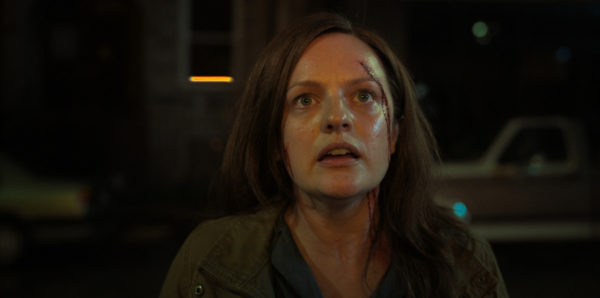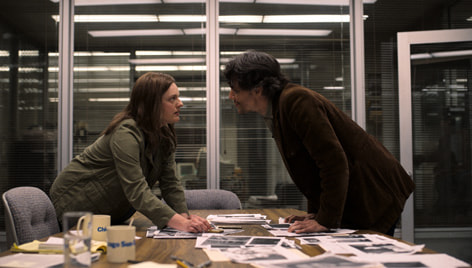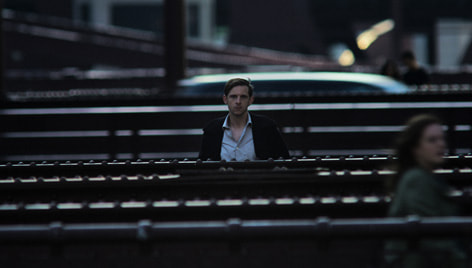
As the serial killer story goes public, killer and survivor finally come face to face as Shining Girls hits its mid-way point.
Spoilers follow for episode 4.
Missed a review? Episodes 1-3
Episode 4 “Attribution”: As pressure mounts to go to print, Dan (Wagner Moura) explores possible connections between the murder victims. Kirby (Elisabeth Moss) tries to make sense of a piece of evidence.
The fourth episode of Shining Girls is firmly focused on Kirby as she comes to realize that the only way to ensure the story gains traction is to become the face of the murders; in effect she must assume the role of survivor.
Shining Girls emphasizes this with its opening, which finds the camera slowly tracking and pushing in on Harper (Jamie Bell)’s victims over the years, finally finishing in 1986 at the beach where the body of Sharon (aka Kirby) has been discovered. The rest of the pre-credits opening finds Rachel (Amy Brennneman) angrily demanding to see her daughter at the hospital, which Harper has infiltrated. He very nearly finishes his work before he’s caught by a nurse, though it’s unclear why he doesn’t keep better track of Sharon/Kirby before he finally comes face to face with her at episode’s end.
The majority of “Attribution” finds both Kirby and Dan preparing for the story to go public. Dan catches the team at the paper, including Marcus (Chris Chaulk), up to speed. And while the newsroom is galvanized to get to work, not everyone is as cautious as Dan, which nearly results in them getting scooped when another paper begins to connect the dots of their investigation. This accelerates the timeline, but also requires changing the parameters of the story; without more time to develop a stronger case, Kirby realizes the story requires an anchor. With time of the essence, she finds the strength to step up and own her survival in order to hold the story together.
It’s a big moment for the character, though it’s not actually the most significant development of the episode. After she and Dan connect the objects left in the victims to the killer (as oppose to his victims), Kirby reaches out to inform planetarium employee Jinny (Phillipa Soo) of the danger. The woman remains hesitant to get involved, but at least she’s more open to listening. Of course we know from the conclusion of the first episode that she’s already doomed, so this only feels more tragic, especially when she sets off to work in the rain, pausing to purchase a familiar red umbrella.

Kirby and Marcus visit an audio technician and it’s another significant break-through in the case, even if Kirby doesn’t entirely understand the implications. Listening to Julia Madrigal’s answering machine, Kirby learns of Harper’s impossible ability to play recorded audio of his victims before they’ve said it (we saw this happen back in episode two). This prompts Kirby to remember a buried memory of the time she was working as PA/groupie of her mother’s band and had the same unnerving experience at a venue warm-up.
Not only is this scene extremely unnerving, it’s another great opportunity for Shining Girls to visually and aurally connect Kirby’s experience to the other women. It’s important because while the series has done an admirable effort of fleshing out her trauma and experience, it hasn’t done nearly as much with the other victims, who are glimpsed as either random bodies (see: the opening of the episode) or secondary characters without much depth (see: Jinny and, to a lesser extent, Julia).
Everything comes to a head as Harper closes in on the “one that got away” – following Kirby to Jinny’s house, and then to LaundryLand, which – as we have previously seen – is the same address as the Bee Happy bar. Kirby investigates the location of the matchbook left inside her back in 1986 until she’s confronted by Harper, who seems nearly as confused as her about the changes to the timeline. Earlier in the episode he attacked the man living in 2B, which establishes that although Harper has a greater control of the timeline, he’s not immune to its weird fluctuations. In LaundryLand, he struggles with the changes in Kirby’s appearance, noting that she “looks different. I don’t like you like this.”
He then attempts to attack her, in a scene that feels too brief after so much build-up. Given that this is only the halfway point of the limited series, it makes sense that it’s not more significant. Despite that, their quick struggle – falling through a wall and prompting another change in the physical environment – plays more like a cruel tease. Obviously this isn’t the time for a full-blown confrontation, but this brief skirmish doesn’t quite satisfy.

Other Observations:
- During their struggle, Kirby manages to pull down Harper’s shirt to reveal a tattoo. It’s important to note that not only does she finally have a face to put to the voice that terrorized her, but she now has more than a few identifying characteristics to create a sketch from.
- “Attribution” finally sees Kirby opening up to people other than Dan. In addition to reconnecting with Jinny, she spends a significant amount of time with Marcus. Seeing the pair of them joke on the L-Train en route to the audio specialist is a really nice scene, especially given the arm’s length distance she’s kept Marcus at since he became her husband in this timeline. Just seeing Kirby smile feels like big progress!
- After episode 3’s heavy emphasis on Dan’s drinking problem, I appreciate the subtle, but knowing inclusion of him casually day drinking in his car between interviews. It visually reinforces that his drinking is still happening without pausing the narrative so that someone can remark on it.
Shining Girls airs Fridays on AppleTV